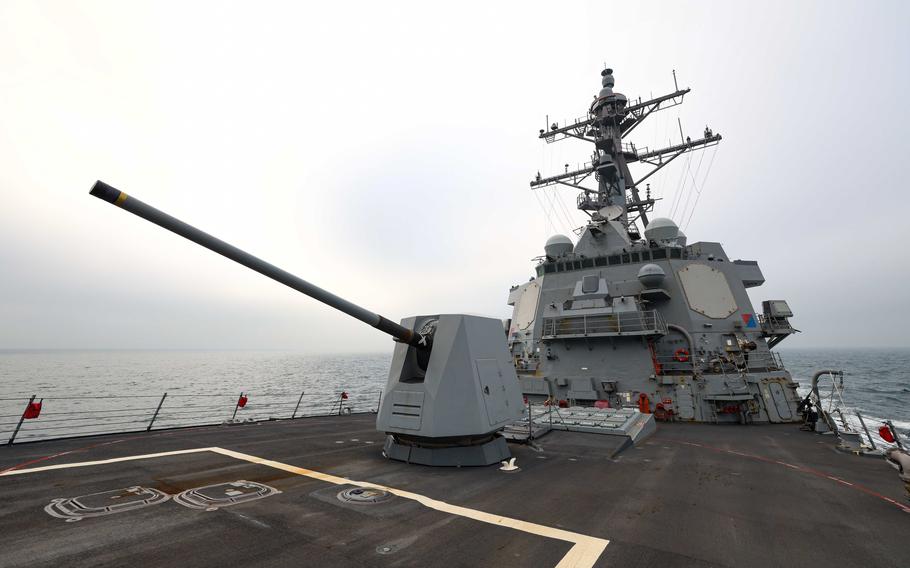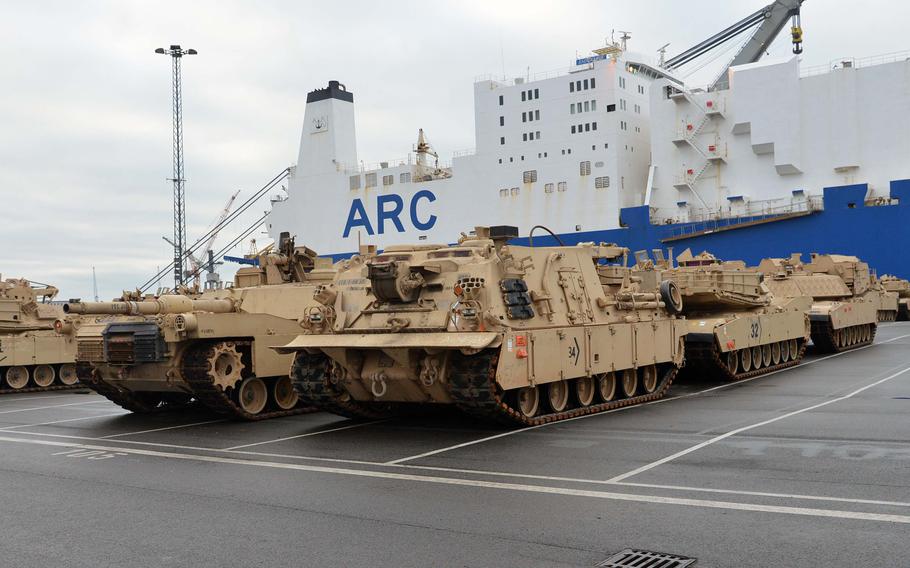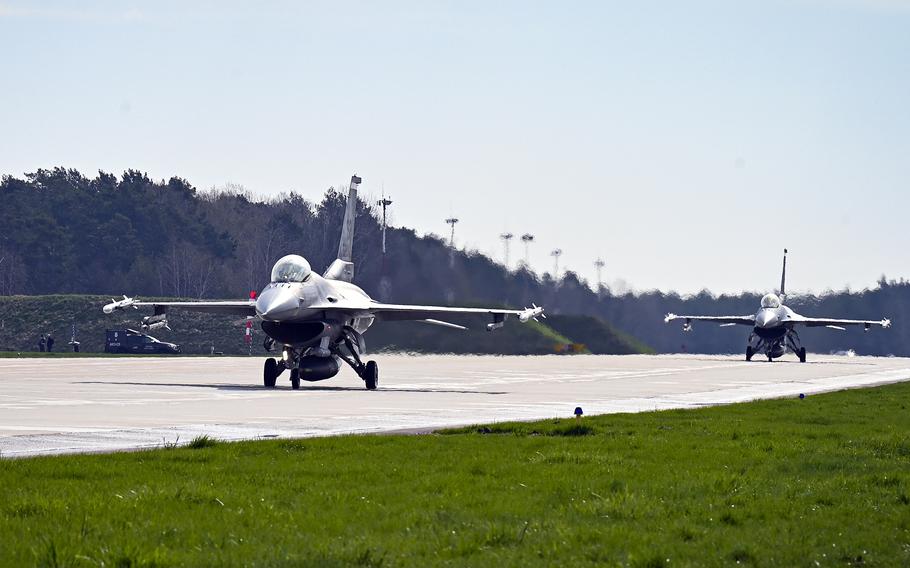
The destroyer USS John Finn conducts routine operations during a Taiwan Strait transit on March 5, 2024. (Justin Stack/U.S. Navy)
STUTTGART, Germany — The decade-long spending jolt that has fueled an expanded U.S. military mission in Europe could be on the chopping block if Donald Trump becomes president again and turns more attention on national security toward China.
The debate over Pentagon priorities and the strategy to meet them is heating up with the U.S. presidential election less than six months away.
An argument playing out now in defense circles centers on whether the U.S. can at once credibly deter China in the Pacific, underwrite the bulk of the security in Europe and rebuild a depleted defense industrial base worn out by Russia’s war in Ukraine.
In light of the lack of political appetite for major defense spending increases, some influential conservative analysts are making the case that if something must give, it’s America’s level of military commitment in Europe.
“We need to grapple with scarcity,” said Elbridge Colby, who served as a deputy assistant secretary of defense for strategy in the Trump administration. “We don’t have a two-war military. We’re not even sure if we have a one-war military, vis-a-vis China.”

Armor belonging to 3rd Armored Brigade Combat Team, 4th Infantry Division, out of Fort Carson, Colo., sits in the port of Bremerhaven, Germany, in 2017, after being unloaded for the ABCT's nine-month rotation in Poland. Should former President Donald Trump return to the White House, the rotation of armor brigades to Europe could be one thing on the chopping block as focus turns towards China, analysts say. (Michael Abrams/Stars and Stripes)
Colby, a China hawk who has been mentioned as a potential player in a second Trump term, envisions a strategy where European militaries carry the bulk of the security burden on the Continent to free up U.S. forces and defense investments for a major eastward shift.
Colby’s ideas line up with those of various policy hands and politicians in Trump’s orbit, ranging from the conservative Heritage Foundation think tank to Ohio Sen. J.D. Vance, who is in the mix as a possible Trump running mate.
While Trump has been vague on specifics when it comes to military priorities in a second term, the former president’s track record points to a policy that will seek to reduce troop levels in Europe and pressure allies to make up the difference.
The Biden administration has also called on European allies to contribute more to defense, and more of them are now on their way to satisfying spending levels agreed to by NATO.
However, Trump has shown a willingness to go further, with a transactional style that breaks with diplomatic norms.
Options could involve reviving orders not carried out at the end of his first tenure that called for pulling 12,000 troops from Germany and relocating some elsewhere in Europe.
Trump also could carry out a new force design centered on redirecting assets in Europe for an Asia mission.
Speaking at the Munich Security Conference in February, Vance signaled the direction he thought Trump would go.
“I think that the American security blanket has allowed European security to atrophy,” he said. “And again, the point is not we want to abandon Europe. The point is we need to focus as a country on east Asia, and we need our European allies to step up in Europe.”

F-16 Fighting Falcons from the 52nd Fighter Wing, Spangdahlem Air Base, Germany, taxi on the flight line at Lask Air Base, Poland in 2021. Should former President Donald Trump return to the White House next year, analysts expect the U.S. military's focus to turn even further to China, with less emphasis on NATO and Europe. (Madeline Herzog/U.S. Air Force)
The hawk’s view
China is deemed the so-called “pacing threat” at the Pentagon, with a “Pacific pivot” or “rebalance” being Beltway talking points going back to President Barack Obama’s administration.
But that policy hasn’t been matched by any major reorganization in how the Pentagon deploys its troops.
Indeed, Russia’s 2014 invasion of Ukraine and full-scale war in 2022 has made Europe a focal point, with about 100,000 U.S. troops now operating on the Continent.
Since 2014, the Pentagon has pumped billions into Europe to build up infrastructure, such as weapons depots and training ranges to support larger troop rotations, reversing course on a decadeslong post-Cold War drawdown.
In a Trump return, expect troops tagged for such Europe missions to be repurposed for the China threat, said Alex Velez-Green, a senior policy adviser at the Heritage Foundation.
In China, hawks see a competitor that poses challenges on par or even beyond those of the Soviet Union.
Given China’s population, territorial ambitions and industrial capacity, the country has emerged as a rising economic power in a way the Soviet Union never did.
At the same time, the U.S. military industrial base has shrunk since the Cold War-era, raising doubts about the America ability to match China when it comes to churning out military hardware.
Failure to address such issues now risks Chinese economic and military domination across much of the Pacific, hawks contend. This also would open the door to a Chinese invasion of democratic Taiwan, which would create the specter of broader war and send shockwaves through the global economy.
For those reasons, the U.S. will need to be clear with allies about the limits of what it can contribute in Europe, Velez-Green said.
“These are the forces that cannot be in two places at once. They’ll have to be backfilled by our NATO allies,” he said.
The Heritage Foundation’s Project 2025 is an 887-page policy document intended to set the agenda in the event of a second Trump term.
When it comes to security in Europe, the U.S. would continue to provide NATO with a nuclear deterrent, but allies would be expected to field the great majority of conventional forces to deal with Russia, according to Heritage’s policy plan. That will enable the U.S. to reduce its force posture in Europe, the plan states.
Critics, however, counter that a huge U.S. focus on China entails risks.
An emboldened Russia?
In a March report that examined alternatives for the military’s basing posture abroad, the Center for Strategic and International Studies said pulling large numbers of forces out of Europe would increase the chances of Russia making a move on NATO’s eastern flank.
And while shifting responsibility to Europe looks good on paper, it would take allies years to develop the necessary forces and capabilities to carry the military burden against Russia, CSIS argued.
Still, there is broad agreement that the Pentagon is stretched thin.
Rand Corp., a think tank that carries out numerous studies for the military, said challenges posed by China, Russia and the war in Ukraine have the military at an inflection point.
“The U.S. defense strategy and posture have become insolvent,” Rand’s 2023 report said. “The tasks that the nation expects its military forces and other elements of national power to do internationally exceed the means that are available to accomplish those tasks.”
Colby says one obvious mission to curtail in Europe would be the steady rotation of U.S. ground forces.
Under the Pentagon’s European Deterrence Initiative, armored brigades, combat aviation units and other forces are regularly dispatched to Europe on nine-month missions. The campaign has been the heart of EUCOM efforts to bolster NATO’s eastern flank for a decade now.
“I think that rotational forces, those are the areas where you would look first for reductions and where the Europeans need to do more,” Colby said.
Advocates for keeping a strong U.S. presence argue that turning away could leave an opening for Russian President Vladimir Putin to challenge NATO. And if U.S. support for Ukraine disappears, the prospect of a Russian victory there would only increase the odds of a wider war in Europe.
Rather than a big reduction in military commitments in Europe, what’s needed is a big defense budget boost, according to opponents of a policy dominantly focused on China. During the 1980s, for example, U.S. defense spending as a share of GDP was roughly twice today’s Pentagon budget.
But Colby contends that any strategy based on major spending increases is unworkable given today’s budget deficit and political realities.
Europe pulling its weight
The changes China-first analysts envision could upend some of the defense planning underway at EUCOM and NATO headquarters if put into action.
The alliance is at work on regional defense plans for Europe, with a July NATO summit expected to involve action on how to generate forces to implement the strategy.
Such planning makes sense but with one major caveat, Velez-Green said.
“If they’re predicated on the United States still providing the preponderance of forces required to execute (the strategy) … a lot of work is going to need to be done in order to understand the U.S. cannot provide the preponderance of key forces in certain areas,” he said.
Military commanders from NATO countries would likely need to go back to the drawing board if Trump were to take up what the Heritage Foundation and analysts such as Colby are recommending.
“You may end up with regional defense plans that are still quite similar in form, but the guts, if you will, are going to need to be updated to make sure they’re implementable,” Velez-Green said.
Colby said that even in the event of a Russian incursion into NATO territory, the U.S. would need to hold forces back to deter Chinese action against Taiwan.
“I think that’s just common sense, because if we engage those capabilities if the Russians go into NATO — to tie them down or trick them or both — then the Chinese would be kind of nuts not to move on Taiwan,” he said.
Supporters of a big military shake up in Europe say such a shift is justified given the threat China poses to American economic and security interests, U.S. budget constraints and the financial means of European allies.
“If you work with the strategy that I’m proposing, we can get on a sustainable way forward that will preserve the trans-Atlantic alliance for the long haul, which I think is really important,” Colby said. “If you keep wish-casting that we can do everything and walk and chew gum, then you’re much more likely to sink the ship.”
It’s unclear how much appetite the citizenry of nations in Western Europe has for defending eastern nations that feel far more threatened by Russia, even if they are bound by the NATO alliance to provide for collective defense.
But there appears to be a growing awareness among European leaders that U.S. forces could be pulled in other directions given the situation in the Pacific and Trump’s ambivalence about NATO.
The implications of Russia’s war in Ukraine prompted numerous countries to ramp up military spending. Germany is expected to finally hit NATO’s benchmark later this year that calls for spending 2% of gross domestic product on defense.
Defense Minister Boris Pistorius recently said Germany’s goal should be to function as the backbone of conventional defense in Europe. Pistorius also says Berlin needs to consider a return to military conscription.
The upshot for Germany and the rest of Europe is that its collective economic output dwarfs Russia, giving it the means to turn things around.
“The math is kind of jarring,” Velez-Green said. “From an economic perspective if our allies decided to move in a concerted way to field the force that is required to erect a defense on NATO’s eastern front, they could very credibly deter Russia or defeat Russian aggression.”